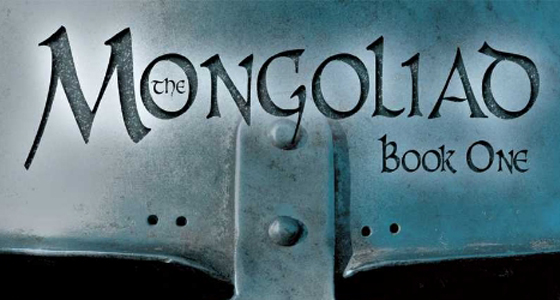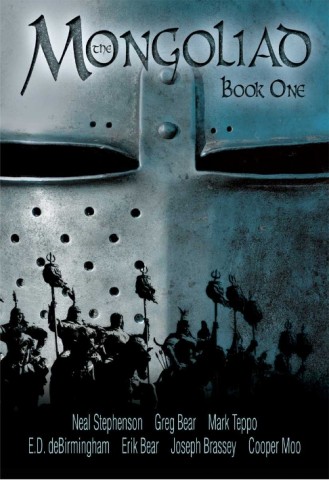Neil Stephenson: The Mongoliad
Neal Stephenson, Greg Bear et al. The Mongoliad. Subutai Corporation. Sep 2010. Web. Dec 2011.
Media Review – published in SFRA Review #297 (2011).
Remembering a forgotten form and thrusting it forcefully into the new millennium with its Web 2.0 communication possibilities, the online publication project The Mongoliad tries to transgress established borders within the literary community that become ever more apparent. With the success of digital technologies, more and more electronic readers, smart phone apps and new distribution concepts on the rise, the traditional book market seems in dire need of new concepts. Authors such as Stephen King, Neil Gaiman, Bruce Sterling or Geoff Ryman have begun experimenting with web novels, hypertext publication, or even Twitter messages as possible ways to engage creative writing in the digital age.
One such example, not the earliest but a fairly successful one, is the serialized online publication The Mongoliad, created by a group of writers and artists spearheaded by SF&F writers Neal Stephenson and Greg Bear. The creative group, going by the collective name of „Foreworld Cabal“, has created a website where readers can subscribe to weekly installments of chapters (currently at #34) written by the Cabal authors and considered the canon. In addition to canonical chapters, the Cabal also provides video footage (e.g. of martial arts techniques), meticulously researched background information on history, technology or characters, maps, artworks and short sidetrack stories that usually would not have been included in a book publication. As such, The Mongoliad proves to be very much prolific of Web 2.0 possibilities, making use of hypertext, links and the multi-media platform of the net, as well as encouraging fan-fiction and other forms of outside creative engagement with the canonical texts. On the other hand though, the publication reminds both of 19th century newspaper serialization and early 20th century pulp magazine’s fan interaction. Bringing back the good ol‘ days of the past to revive the consumption of textual creativity in the present. Similar to the Dickensian reader in Victoria’s London, the postmodern iUser can receive his weekly dosis of The Mongoliad via app store or in Kindle-format, can read anywhere and any time. And just as during the Golden Age of the pulps, fans can write in to the makers, engage in discussion on the plausibility of story aspects, can offer suggestions and critique or plainly become authors, receiving a quasi-Asimov’ian commendation into the canon themselves. At least this is the theory, while in reality fan engagement and the addition of outside material has been rather sparse, aside from some nice fan artworks and the quite common forum-discussions on many topics. The possibilities are here but unfortunately, except for a very limited group, a strong interactive reaction has not happened.
This is not due to an obscurity of the topic itself though, as The Mongoliad picks up a literary trend that has been around for a while but in recent years has even proven to be interesting to mainstream writers. Conceptualized as an alternate history, The Mongoliad squarely situates itself with other examples of the genre such as Philip K. Dick’s The Man in the High Castle (1962), Harry Turtledove’s Ruled Britannica (2002) or even Philip Roth’s The Plot Against America (2004). Within the Foreworld (as the alternate reality is termed on the website), the genre-typical moment of historical divergence happens when the Mongol empire finds itself at the door-step of Western (i.e. European) civilization in 1241. Instead of decamping due to the untimely death of the Second Great Khan, in the Foreworld, Ögedei is alive and the armies remain in Europe to threaten the realm of Christianity as a religion as well as its established mundane, geographical boundaries. As Inken Frost in her review of The Mongoliad (Zeitschrift für Fantastikforschung 1.1 (2011): 140-3) suggests, the several strands of the story narratively mimic what the publication itself tries to do; in both form and content The Mongoliad deals with the „crossing of boundaries (technical, structural, geographical…) and the forming of communities in the newly created contact zones“ (Frost, p.141). But whereas the characters of The Mongoliad succeed in transgressing boundaries of religion, nationality and gender, and where the Foreworld as literary creation represents a changed historical perspective (and a content oriented analysis within the genre here might prove very interesting indeed), the technical boundary posed by what Henry Jenkins calls „participatory culture“ (Convergence Culture: Where Old and New Media Collide. New York: NY UP, 2006; p.3) has on a mass-audience level not been breached. Where a Web 2.0 savvy digital elite might move swiftly from audience to author to critic and back to audience again, hopping between text, film and artwork to participate in the creation and consumption of a product of „convergence culture“, the majority of readers does not – yet. The Mongoliad will continue (at least till October this year), and hopefully, as new audiences get more and more accustomed with interactive offers such as this, it will become part of what a new creative form. Only time will tell.
Citation: Schmeink, Lars. „The Mongoliad.“ Review. SFRA Review 297 (2011): 62-63.
Download PDF of article. >> Mongoliad Review.

